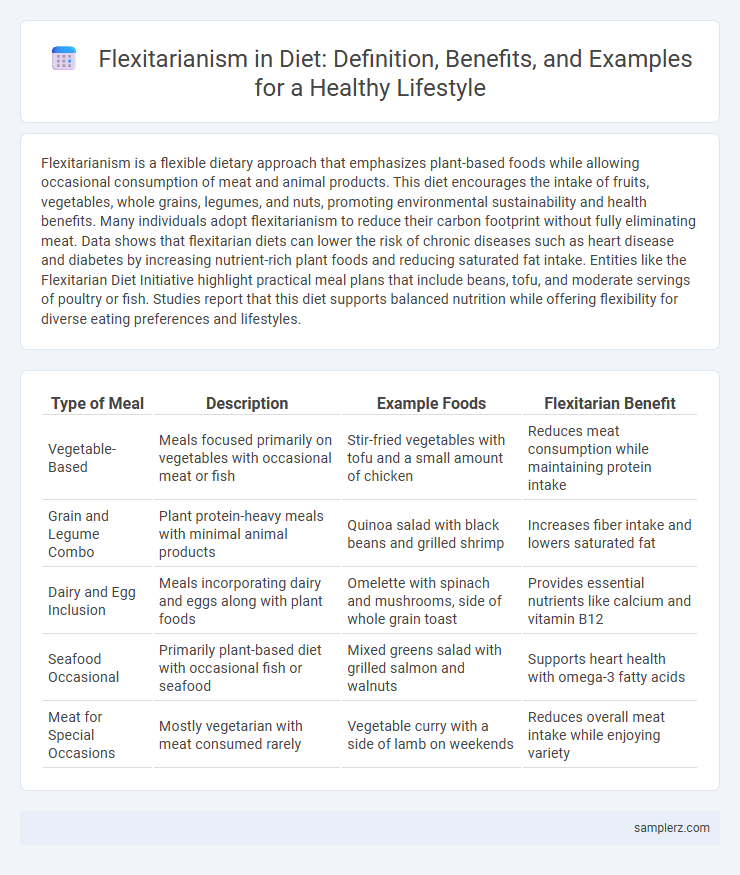Flexitarianism is a flexible dietary approach that emphasizes plant-based foods while allowing occasional consumption of meat and animal products. This diet encourages the intake of fruits, vegetables, whole grains, legumes, and nuts, promoting environmental sustainability and health benefits. Many individuals adopt flexitarianism to reduce their carbon footprint without fully eliminating meat. Data shows that flexitarian diets can lower the risk of chronic diseases such as heart disease and diabetes by increasing nutrient-rich plant foods and reducing saturated fat intake. Entities like the Flexitarian Diet Initiative highlight practical meal plans that include beans, tofu, and moderate servings of poultry or fish. Studies report that this diet supports balanced nutrition while offering flexibility for diverse eating preferences and lifestyles.
Table of Comparison
| Type of Meal | Description | Example Foods | Flexitarian Benefit |
|---|---|---|---|
| Vegetable-Based | Meals focused primarily on vegetables with occasional meat or fish | Stir-fried vegetables with tofu and a small amount of chicken | Reduces meat consumption while maintaining protein intake |
| Grain and Legume Combo | Plant protein-heavy meals with minimal animal products | Quinoa salad with black beans and grilled shrimp | Increases fiber intake and lowers saturated fat |
| Dairy and Egg Inclusion | Meals incorporating dairy and eggs along with plant foods | Omelette with spinach and mushrooms, side of whole grain toast | Provides essential nutrients like calcium and vitamin B12 |
| Seafood Occasional | Primarily plant-based diet with occasional fish or seafood | Mixed greens salad with grilled salmon and walnuts | Supports heart health with omega-3 fatty acids |
| Meat for Special Occasions | Mostly vegetarian with meat consumed rarely | Vegetable curry with a side of lamb on weekends | Reduces overall meat intake while enjoying variety |
Introduction to Flexitarianism: A Balanced Dietary Approach
Flexitarianism emphasizes a primarily plant-based diet while allowing occasional consumption of meat and animal products, promoting flexibility and nutritional balance. This approach supports sustainability by reducing meat intake and increasing fiber-rich fruits, vegetables, and legumes, contributing to improved heart health and weight management. Celebrities like Beyonce and influential nutritionists endorse flexitarianism for its adaptability and positive environmental impact.
Key Principles of Flexitarian Eating
Flexitarianism emphasizes primarily plant-based foods while allowing occasional meat and animal products, promoting a balanced approach to nutrition. Key principles include reducing meat consumption, increasing intake of fruits, vegetables, legumes, and whole grains, and selecting nutrient-dense, minimally processed foods. This flexible diet supports sustainability, improves health outcomes, and accommodates individual preferences without strict restrictions.
Plant-Based Meal Ideas for Flexitarians
Flexitarians often incorporate plant-based meal ideas such as chickpea and vegetable stir-fries, quinoa salads with mixed greens and avocado, and lentil-based soups rich in fiber and protein. These meals offer nutrient-dense options that reduce meat consumption while maintaining balanced nutrition. Emphasizing seasonal vegetables and whole grains enhances flavor and supports sustainable eating habits within a flexitarian lifestyle.
How to Incorporate Animal Protein Responsibly
Flexitarianism encourages the reduction of animal protein consumption by prioritizing plant-based foods while including occasional servings of ethically sourced meat, poultry, or fish. Incorporate animal protein responsibly by choosing organic, free-range, or sustainably farmed options that support environmental health and animal welfare. Balancing plant-based meals with measured portions of high-quality animal products helps maintain nutritional adequacy and reduces the overall ecological footprint.
Flexitarian Breakfast: Nutritious Start to the Day
A flexitarian breakfast often combines plant-based foods with occasional animal proteins, like eggs or Greek yogurt, to provide balanced nutrition rich in fiber, protein, and essential vitamins. Incorporating ingredients such as whole grains, fresh fruits, nuts, and seeds supports sustained energy levels and digestive health. This approach promotes a flexible, sustainable diet that prioritizes nutrient-dense, minimally processed foods for optimal wellness.
Lunch Recipes That Embrace Flexitarian Choices
Lunch recipes that embrace flexitarian choices often include plant-based proteins like lentils, chickpeas, and tofu combined with seasonal vegetables to create nutrient-dense meals. Incorporating whole grains such as quinoa or brown rice alongside occasional lean meats like grilled chicken or fish balances flexibility with health. These recipes emphasize reducing meat consumption while maintaining flavor and essential nutrients, supporting sustainable and mindful eating habits.
Flexitarian Dinner: Mixing Plants and Proteins
A flexitarian dinner often features a balanced combination of plant-based ingredients such as quinoa, roasted vegetables, and leafy greens alongside moderate portions of lean proteins like grilled chicken or legumes. This approach supports nutritional diversity and promotes sustainable eating habits by reducing overall meat consumption. Incorporating seasonal produce and plant proteins enhances flavor while maintaining the flexibility central to the flexitarian lifestyle.
Snack Options for the Flexitarian Lifestyle
Snack options for the flexitarian lifestyle include a diverse range of plant-based foods such as hummus with vegetable sticks, roasted chickpeas, and mixed nuts paired with seasonal fruits. Incorporating dairy or occasional lean proteins like turkey slices or boiled eggs provides balance while maintaining predominantly vegetarian choices. These snacks support nutritional variety and align with the flexible dietary approach of consuming mostly plant-based foods with moderate animal product inclusion.
Flexitarianism for Families: Inclusive Meal Planning
Flexitarianism for families emphasizes flexible, plant-forward meal planning that incorporates occasional lean meats and animal products to promote balanced nutrition and sustainability. Incorporating versatile ingredients like beans, legumes, whole grains, and seasonal vegetables encourages diverse and nutrient-rich meals suitable for all ages. Family-friendly flexitarian recipes often blend familiar flavors with new plant-based options, making it easier to transition to a healthier, eco-conscious lifestyle together.
Flexitarian Diet Benefits: Health and Environmental Impact
Flexitarianism emphasizes a predominantly plant-based diet with occasional inclusion of meat, offering significant health benefits such as reduced risk of heart disease, diabetes, and obesity due to higher consumption of fruits, vegetables, and whole grains. This dietary approach supports environmental sustainability by lowering greenhouse gas emissions, conserving water, and reducing land use compared to traditional meat-heavy diets. Flexitarianism promotes balanced nutrition and eco-friendly living, making it a practical and impactful choice for improving personal health and protecting the planet.

example of flexitarianism in diet Infographic
 samplerz.com
samplerz.com